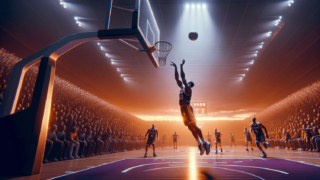
8-Second Backcourt Violation Rule in Basketball
Written by: Basketball Universe
Last updated:

So you want to get the inside scoop on one of the most thrilling and nerve-wracking time limits in basketball? Well, buckle up, because we’re about to dive into the exhilarating world of the 8-second backcourt violation rule! This nifty little rule adds a pinch of excitement to the game and poses a challenge to strategize against the ticking clock. In this blog post, we’ll dissect the importance of this rule, its impact on gameplay, and how you can use it—and avoid it—like a true basketball pro. So, whether you’re an avid fan or an aspiring player, this comprehensive guide has got you covered on everything you need to know about the 8-second backcourt violation rule.
8-Second Backcourt Violation Rule in Basketball
The 8-second backcourt violation rule in basketball requires the team with possession to advance the ball past half-court within eight seconds. This rule prevents stalling tactics and keeps the game’s pace moving. If a team fails to cross half-court within the allotted time, the opposing team is awarded possession of the ball.
History of the 8-Second Rule
The evolution of the 8-second rule can largely be attributed to speeding up the game and discouraging stalling tactics. Before its implementation, teams would sometimes keep the ball in the backcourt without any time limitations, leading to slow-paced games. The NBA introduced the rule in the 2001-2002 season, while FIBA and the WNBA already had the rule in place during the 1990s to improve the flow and excitement of basketball matches. Now that we know why this rule exists let’s break down the essentials of the 8-second rule in more detail.
Basics: Understanding the 8-Second Rule
The 8-second rule becomes relevant the moment a team gains possession of the ball. As soon as they have the ball in their hands, the countdown begins. In NBA, FIBA, and WNBA leagues, you have precisely eight seconds to move the ball from the backcourt (where the team’s basket is) to the frontcourt (where the opponent’s basket is). This rule is not applied in NCAA basketball, where they follow a 10-second backcourt violation instead. Crucially, if you fail to do so, the opposing team gets possession – a situation every player aims to avoid.
Key Basketball Rules: When the 8-Second Clock Resets
The 8-second rule seems pretty straightforward, right? But there’s more to it than that. Specific situations may cause a reset in the timer or the clock not to start at all. Let’s take a look at some of these scenarios:
1. After a shot-clock violation
If a team commits a 24-second shot-clock violation, the opposing team will then regain possession of the ball. When they get control, their 8-second backcourt violation clock is reset.
2. After a jump ball
In the event of a jump ball, the shot clock will reset to a new 24 seconds, and the 8-second countdown will not start until the team has gained clear possession of the ball in the backcourt.
3. Change of possession via a loose ball
If the ball becomes loose in the backcourt and the opposing team gains possession, the 8-second clock resets, granting the new team a fresh countdown as they advance the ball to the frontcourt.
4. Following timeouts
After a timeout, should the ball be inbounded in the backcourt, the 8-second countdown does not reset. Instead, the time remaining on the 8-second clock at the point of the timeout continues ticking down once the game resumes.
Violations and Consequences
Failing to comply with the 8-second rule can be costly, as your team will lose possession of the ball. A few common situations that may result in backcourt violations are as follows:
1. Failed attempt to cross half-court
If a player fails to move the ball past half-court within the allotted 8 seconds, the opposite team immediately gains possession. The countdown timer is strict, leaving no room for error.
2. Stepping on or over the half-court line
Once a player has both feet and the ball cross the half-court line, returning the ball to the backcourt is considered a violation. Remember, unlike when you attempt to cross into the frontcourt, there’s no limit on the time you can spend in the backcourt after a successful transition.
3. Inbounding the ball unsuccessfully
If a player tries to inbound the ball directly into the frontcourt and an opponent deflects it back into the backcourt, this is not considered a violation. However, if the original inbounding player intentionally sends the ball back to the backcourt and a teammate catches it, it becomes a violation.
8-Second Rule Management Strategies
Comprehending the ins and outs of the 8-second rule is essential to gameplay. Now let’s explore a few strategic tips to help you and your team master the rule and gain a competitive edge.
1. Be mindful of the clock
As a player, be aware of the 8-second countdown at all times, especially right after your team gains possession. Staying vigilant of the ticking time will make you more efficient in getting the ball over half-court.
2. Develop effective communication
Good communication is key in any team sport. Ensure your teammates remain informed of the time left on the 8-second clock, and use clear signals or calls to help each other out.
3. Stay organized on the court
Getting the ball over half-court is easier when your team is well-positioned. Be mindful of your spacing and ensure you make yourself available to receive passes from teammates when facing strong backcourt pressure.
4. Utilize the dribble to advance the ball
If passing seems too risky, use your dribbling skills to advance the ball into the frontcourt. Work on improving your ball handling and dribbling abilities, allowing you to maintain greater control under pressure.
Playing Against the 8-Second Rule
Just as crucial as managing the rule offensively, learning how to capitalize on your opponents’ attempts to avoid backcourt violations can provide an added advantage. Here are some essential tips:
1. Apply pressure on opposition ball handlers
Defensive pressure can force players into making mistakes or slow them down, increasing the chances of a backcourt violation. Maintain strong pressure without fouling throughout the first few seconds of an opponent’s possession.
2. Exploit passing lanes
Identify and disrupt your opponents’ intended passing lanes to force them to take longer to advance the ball. This tactic can increase the likelihood of an 8-second violation, turning possession in your favor.
3. Master the art of the full-court press
Implementing an effective full-court press demands exceptional athleticism and excellent communication. When performed correctly, this strategy can break up an opponent’s game plan and generate backcourt violations or turnovers.
The 8-Second Rule: A Game-Changer
Understanding the intricacies of the 8-second backcourt rule is a fundamental aspect of basketball strategy. The rule affects the style and pace of play across the sport, challenging coaches and players to maintain a high pace and stay on their toes – be it on offense or defense. The key to success lies in mastering the rule, maximizing your team’s possession, and, ultimately, transforming your game. Stay nimble, focused, and confident as you battle against the clock, and your performance on the court will undoubtedly reap the rewards!
Understanding the Referee’s Role in the 8-Second Rule
The enforcement of the 8-second backcourt violation rule relies heavily on the referees officiating the game. They must maintain a sharp focus on the game’s progression to ensure that they can identify any potential violations in real-time. Knowing the role of the referees in this rule can help you become a more strategic player and appreciate their responsibilities on the court.
Spotting Violations
Referees must watch closely as the team with the ball aims to cross half-court. They observe the players carefully to ensure they do not commit any backcourt violations or inconspicuously break the 8-second rule. Quick thinking and accuracy in decision-making are essential referee qualities, as their calls can alter the outcome of a game.
Signaling Violations
If a referee identifies an 8-second rule violation, they must communicate this to the players on the court. They usually do so by blowing their whistle and making a hand signal that indicates a backcourt violation. It’s important for both players and referees to know these signals and recognize them during gameplay.
The Importance of Practicing Under Pressure
Now that you have a firm grasp of the 8-second rule, be sure to incorporate elements of this rule into your practice routines. Training “under pressure” is a brilliant way to get comfortable handling situations you’ll face in real games.
Drills Incorporating the 8-Second Rule
Coaches can develop drills that simulate 8-second backcourt violation scenarios, paving the way for players to improve their skills under pressure. Here are two helpful practice drills:
1. Full-Court Dribbling Drill
This drill challenges players to dribble from one end of the court to the other within 8 seconds. Incorporating a variety of dribbling moves, such as crossovers and zig-zags, can help players prepare for potential defensive obstacles and improve their ball-handling skills in high-pressure situations.
2. Team-Based Passing Drill
A passing drill that requires players to send the ball from the backcourt to the frontcourt within 8 seconds can mimic game-time conditions effectively. Players learn to communicate effectively, get open, and pass the ball accurately in a time-sensitive scenario. This drill boosts teamwork and game awareness while keeping the 8-second rule in mind.
Wrap Up
A solid understanding of the 8-second backcourt violation rule and its nuances will make you a more knowledgeable and skilled basketball player. When you know the rule inside out and practice it consistently, you’ll be better equipped to adapt to the fast-paced, exciting world of basketball. Remember, be proactive in your strategies, keep an eye on the clock, and make the most of your possession time to gain the upper hand on the court.
FAQs: 8-Second Backcourt Violation Rule in Basketball
Still have questions about the ins and outs of the 8-second rule? You’re in luck! This FAQ section covers the most common queries individuals may have about the backcourt violation rule. Peruse these questions and answers to deepen your understanding even further.
1. Is there an 8-second rule in college basketball?
No, the NCAA (college basketball) follows a 10-second backcourt violation rule instead of the 8-second rule used in the NBA, WNBA, and FIBA leagues.
2. Does the team get to advance the ball after an 8-second violation?
No, possession is given to the opposing team after an 8-second violation. The team that committed the violation loses its possession and does not advance the ball.
3. Where is the ball inbounded after an 8-second violation?
The ball is inbounded on the sideline, near the half-court line, and given to the opposing team to gain possession after an 8-second violation.
4. What happens if the ball is accidentally deflected into the backcourt?
If the defensive team accidentally deflects the ball into their backcourt, the 8-second rule does not reset. The offensive team can retrieve the ball without committing a violation.
5. Do timeouts reset the 8-second clock?
No, timeouts do not reset the 8-second clock. The time remaining on the 8-second clock at the point of the timeout will continue once the game resumes.
6. Does the 8-second clock reset if a shot is taken but not made and the same team rebounds?
If a team attempts a shot within eight seconds but misses and manages to rebound the ball, the 8-second clock does not reset; it only resets when a new 24-second shot clock begins.
7. If a team rebounds on offense and passes it to the backcourt, is it a violation?
Yes, if a team rebounds the ball and intentionally passes it back to its backcourt, it is considered a backcourt violation. However, if the offensive rebound is deflected to the backcourt by a defender, it is not a violation.
8. What is the relationship between the 8-second rule and the shot clock?
The 8-second rule is linked with the 24-second shot clock because after advancing the ball past half-court (within 8 seconds), the shot clock starts its countdown. The two rules work together to speed up the game and create a faster, more exciting gameplay.
9. How do referees keep track of the 8-second countdown?
Referees rely on both the game clock and their sense of timing to keep track of the 8-second countdown. They are trained to monitor time-sensitive elements of the game vigilantly and communicate any violations to players clearly and efficiently.
10. Is the 8-second rule the same across both men’s and women’s basketball?
Yes, the 8-second rule applies uniformly across both men’s and women’s basketball games in the NBA, WNBA, and FIBA leagues. In contrast, the NCAA follows a 10-second rule for both men’s and women’s college basketball.
Featured Posts
- No pillar pages found.





